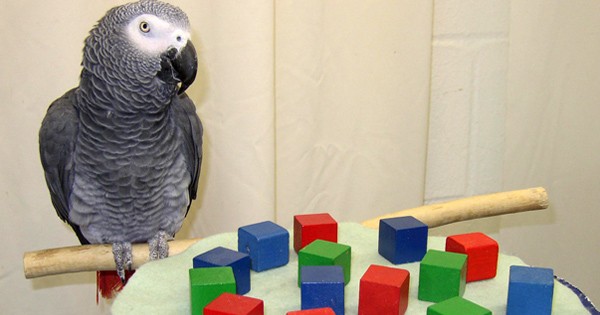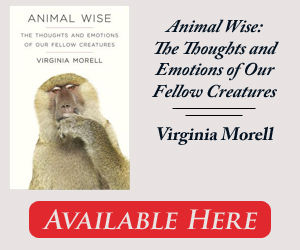
Animal Wise: The Thoughts and Emotions of Our Fellow Creatures, By Virginia Morell, Crown, 291 pp., $26
Recently, at a public hearing I attended about an agriculture bill in my state, a man rose to speak. Gathering his thoughts, he began with a comment with which he thought everyone would agree: “Of course, I recognize that humans are a higher form of life than animals …”
Bullhockey, says Virginia Morell. “We are not more highly evolved—either physically or mentally—than our closest genetic ancestor, the chimpanzee”—or any other animal, for that matter, she writes in Animal Wise. The notion that humans are the pinnacle of evolution is as outdated as the pocket protector, and so is its corollary, that we alone possess intelligence. “Animals have minds,” Morell proclaims in the book’s first sentence. Then, for page after exciting page, she shows them making decisions, remembering the past, planning the future, and helping others in distress.
Morell, a correspondent for Science magazine, pulls her examples from the findings of researchers who are revolutionizing our understanding of “what was once one of the most forbidden realms on earth”: the animal mind. Their discoveries are breathtaking. Fish use tools. Honeybees plan. Rats laugh. Female crickets remember the courtship songs of different males. Elephants look into mirrors and realize they are seeing a reflection of themselves, not another elephant.
Some of these scientists are famous. Jane Goodall, renowned for her research with the chimpanzees of Gombe, Tanzania, demonstrated that, like people, animals make and use tools, wage war, purposely deceive one another, and form powerful political alliances. More recently, Irene Pepperberg rocked the scientific establishment with news that her African gray parrot, Alex, could count, add, joke, and understand the concept of zero—the bird told her so in plain English.
Morell’s chapters bring yet more news from these old friends, but I was more curious about the pioneering work of lesser-known scientists working with less charismatic species. Take Nigel Franks at the University of Bristol, who has demonstrated that rock ants, patiently and at great risk to themselves, teach other ants. He first gave individual ants identities by painting them with colored dots, videotaped them, and watched the tapes magnified on a computer screen. Only then was he able to see the drama that unfolded among the hyphen-sized, cinnamon-colored ants when catastrophe struck. Franks destroyed their nest and offered them a new one, provided they could find it. Here we meet “Teacher White,” a scout ant marked by a white dot on her abdomen, and “Pupil Red,” her student marked in crimson. “Pupil Red didn’t simply follow her teacher’s chemical trail to the new nest but had to learn the landmarks along the way,” Morell writes. “That was why she moved so slowly, stopping now and then to swing her head like a cow, left and right, almost as if searching for clues”—a task Morell likens to “simultaneously walking and memorizing the skyscrapers of Lower Manhattan.”
Through repeated experiments, Franks deciphered the mechanics of ant education. Once the student learns a section of trail, she taps her antennae against the legs of her teacher, signaling her to proceed. Sometimes, though, the student gets lost. When this happens, Teacher White waits patiently—sometimes a minute or longer—until her student signals that she has learned that part of the route and is ready to continue.
During these long lessons, both teacher and student face grave danger. Being out in the open is hazardous for an ant. The teacher, having already found the new nest, might easily remain safely there. But incurring risk is part of the definition of teaching: the teacher, wrote Franks, paraphrasing a widely accepted definition developed by biologists Tim Caro and Marc Hauser in 1992, modifies “its behavior in the presence of another, at a cost to itself, so that another individual can learn more quickly.”
At least that was the generally accepted definition of teaching—until Franks’s research was published. Though many fellow researchers accepted his work, others tried to change the definition of teaching to exclude what he had documented. This sort of scientific reticence brings to mind paleoanthropologist Louis Leakey. After learning that his onetime protégée Jane Goodall had proved that tool use, then considered a uniquely human behavior, was also common among chimpanzees, he wrote, “Now we must redefine tool, redefine Man, or accept chimpanzees as humans.”
But let’s leave humans out of this for a moment, Morell suggests. She resists the urge to close her fine book with musings on what makes humans special. Bravo. It’s humbler, wiser, and more instructive to stop looking down at animals from an imaginary evolutionary pinnacle and, instead, to try to see them as fellow thinking, feeling beings with minds as worthy of understanding as our own.



